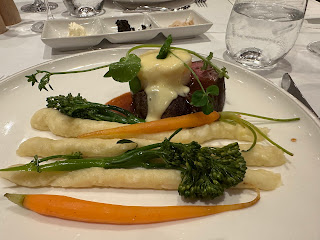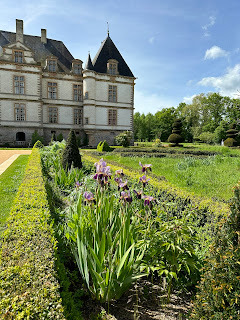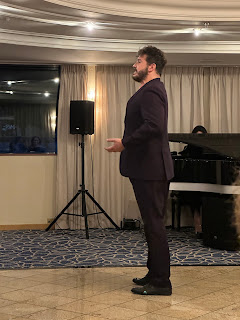For our final long bus ride of the cruise, we drove back out into the area around Cluny Abbey, this time to visit the Chateau de Cormatin. The chateau has a connection with the Abbey in that in 1280 the original owner, Henri de Ble, built a fortified house to control the path leading to Cluny Abbey. Recall that this was when there were many, many pilgrims visiting the Abbey, and if he could exact a small fee for using the road, he would make a lot of money. In 1606 his descendent, Antoine, decided the house wasn't enough and built a castle there instead.
The drive through rural Burgundy was quite lovely and we went through a number of villages that dated back hundreds of years on the way.
The Castle has a long history, including a very interesting story about how it was not taken over or destroyed during the French Revolution. During the 'Great Fear' of 1789 which was the precursor to the Revolution, Burgundy Wine apparently saved the day when a mass of rioters stormed up, ready to burn the place down. Pierre Dezoteux, husband of the owner, Sophie Verne, decided to give them the contents of the wine cellars to calm them down - and it worked! And even during the Revolution, Sophie and her 6 children were safe in the castle, as it was never attacked. Those rioters must have known that wine was particularly valuable.
 |
| The chateau even has a pair of resident storks. They will come back to their nest every year, and we know there are at least a couple of young chicks in there. |
The recent history of the castle began in 1980, when three friends purchased it for a literal pittance of about 250,000 Francs. It was in ruins at the time, but they did want to restore it and furnish it as a historical museum. Once they began restoration, they found some of the painted walls and ceilings that had disappeared under about 300 years of dust. They also discovered some beautiful paintings.
Since about 1990, they have put about 250,000 Euros per year into the restoration, having now spent over 5 Million Euros in renovation, decorating, and purchasing antiques of the periods they want to display. They manage to fund this mainly through the entrance fee paid by the 60,000 visitors they welcome every year. Happy to do our part!
 |
| A beautiful fan fireguard |
 |
| The Marquis' bedroom, hung with tapestries from the mid-1600s |
 |
| The kitchen, which had been the Marquis's antechamber until Sophie and her kids spent the Revolution alone. She moved the kitchen closer to the living quarters |
 |
| The St.-Cecilia Cabinet, or the Marquis's office. All of this decoration was found under the dust and is now the best preserved piece of early 17th century decoration in France |
 |
| The Marquise's bedroom, where she not only would sleep, but also eat and receive guests |
 |
| The Antechamber where visitors waited to be received |
 |
| A look out from one of the upstairs windows |
 |
| The aviary/gazebo on the left |
 |
| The view over part of the labyrinth toward the castle |
They also recreated a kitchen garden behind one of the outbuildings, as they do actually live in a separate wing of the castle. It isn't large, but they have some lovely plants, herbs and even orange and lemon trees in tubs.
 |
| Salad |
 |
| Pumpkin Cream Soup |
 |
| Deconstructed 'Kartoffelpuffer' (potato pancake) with Scallop.....not quite what I expected, but it tasted good |
 |
| 'Land and Sea' - a small steak with a large shrimp |
 |
| Special chocolate mousse dessert. That blob on the left is a smoke bubble that managed to make it to the table before it popped! |
After dinner we had some local entertainment - a couple of singers with their pianist and soprano sax accompanists. Beautiful French music, lovely voices and quite the sense of humour - we had a great evening.








































